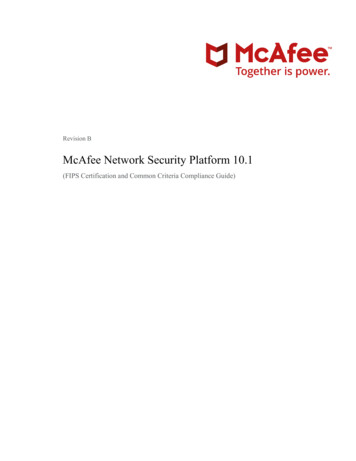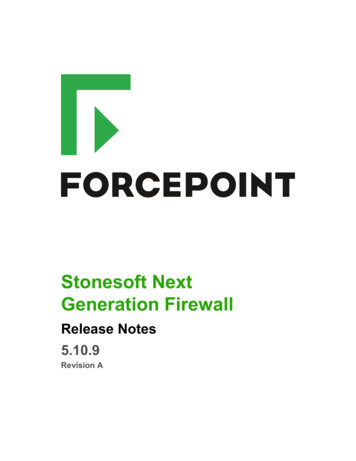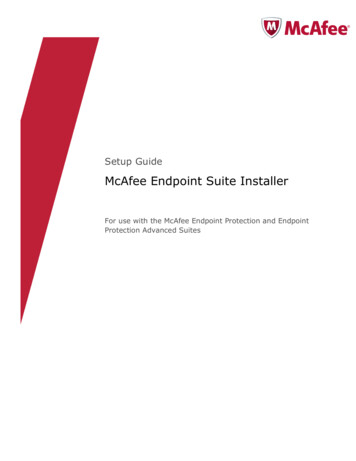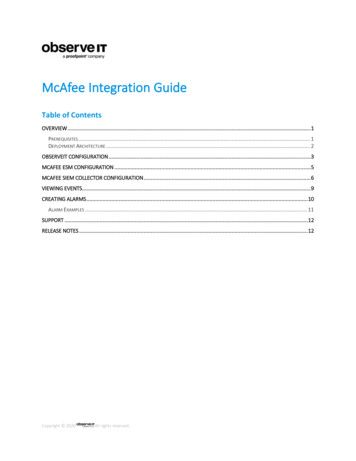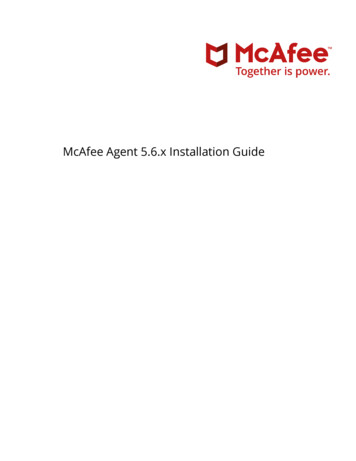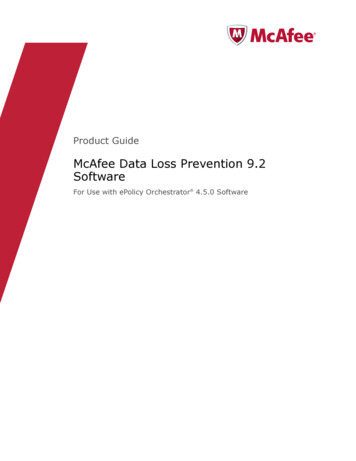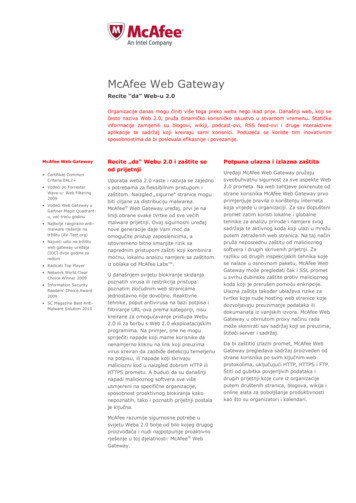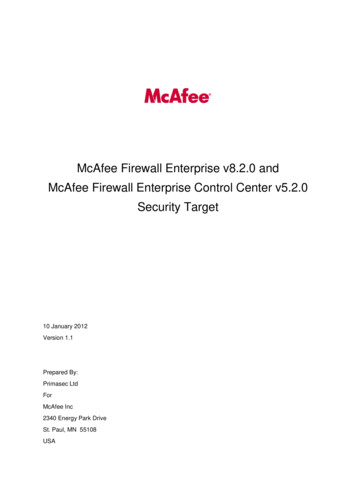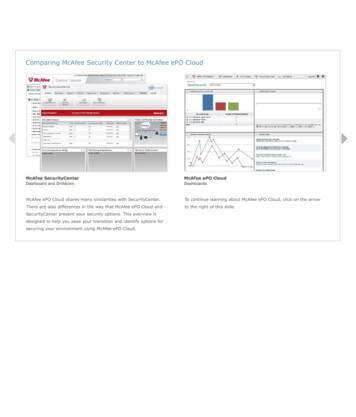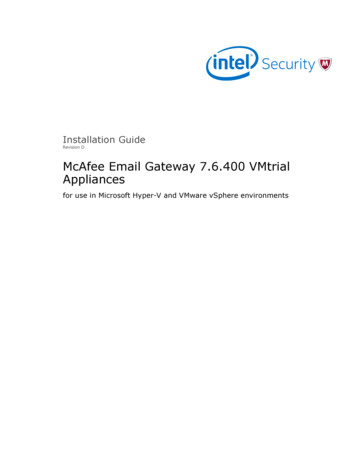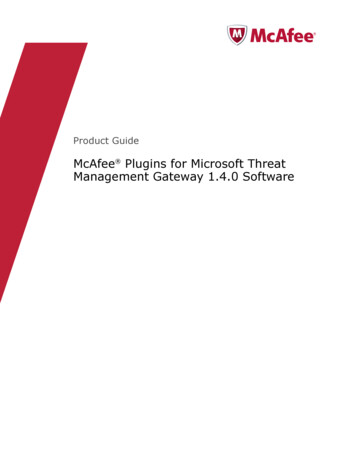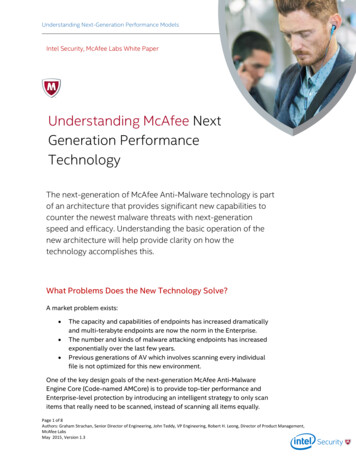
Transcription
Understanding Next-Generation Performance ModelsIntel Security, McAfee Labs White PaperUnderstanding McAfee NextGeneration PerformanceTechnologyThe next-generation of McAfee Anti-Malware technology is partof an architecture that provides significant new capabilities tocounter the newest malware threats with next-generationspeed and efficacy. Understanding the basic operation of thenew architecture will help provide clarity on how thetechnology accomplishes this.What Problems Does the New Technology Solve?A market problem exists: The capacity and capabilities of endpoints has increased dramaticallyand multi-terabyte endpoints are now the norm in the Enterprise.The number and kinds of malware attacking endpoints has increasedexponentially over the last few years.Previous generations of AV which involves scanning every individualfile is not optimized for this new environment.One of the key design goals of the next-generation McAfee Anti-MalwareEngine Core (Code-named AMCore) is to provide top-tier performance andEnterprise-level protection by introducing an intelligent strategy to only scanitems that really need to be scanned, instead of scanning all items equally.Page 1 of 8Authors: Graham Strachan, Senior Director of Engineering, John Teddy, VP Engineering, Robert H. Leong, Director of Product Management,McAfee LabsMay 2015, Version 1.3
Understanding Next-Generation Performance ModelsAMCore Performance Model: The Actors in the DramaIn the new AMCore performance model, the strategy is based around the notion of an ‘actor’.An actor is defined as a running process and its state of trust (as seen below). The state can beone of three values: Suspicious: The actor has done something or has come from someplace on the web that is nottrusted, e.g. a website that is known to host malware downloads.Normal: This is another way of saying “Unknown”. The actor is in a state that we have notdetermined to be suspicious or trusted yet.Trusted: The actor is trusted, e.g. is a known part of the OS, has come from a trusted origin (e.g.Microsoft Signed Installer), or is directly related a trusted package (e.g. a DLL that is part of atrusted application package)SuspiciousScanNormalTrustedActor: Arunningprocess andits stateProcess* Base image* Loadable Images* Events* Read and Write OperationsWhy is the process referred to as an “Actor”? When doing behavioral observations, the “actor”is the process that is “performing” events. It is nomenclature that is used to reflect the processthat is “acting”, that is being observed, hence the name “Actor”.AMCore does an initial scan of the Actors in an endpoint, and does an initial classification of itsstate, based on the body of knowledge that AMCore has available to it. This initial scan isextremely low-impact (i.e. it is very fast) as it is not the same as doing signature scanning –rather it is performing a rapid initial state classification.The Process is a combination of base image, loadable images, and what the process has beingdoing – events and/or read/write operations. The base image and loadable images are objectsthat are potentially hash-able, based on whether we have a priori knowledge of whether thatprocess is malicious or not, whether they have a signed certificate, or a hash value that isPage 2 of 8Authors: Graham Strachan, Senior Director of Engineering, John Teddy, VP Engineering, Robert H. Leong, Director of Product Management,McAfee LabsMay 2015, Version 1.3
Understanding Next-Generation Performance Modelsknown to be trusted. Base images and loadable images are used to help classify actors asbeing trusted.The events are behaviors, and reflect “what the file/process has been doing”, and cancontribute to whether we classify the file as suspicious or trusted, as can the read/writeactivities of the process. The events and read/write operations help AMCore to classify actorsare being malicious.AMCore has built-in behavioral classification technology that can help to quickly classify anactor as potentially malicious or not. A key point in understanding how this methodology canincrease performance is realizing that AMCore can classify large groups of actors as trusted(e.g. through inheritance, canonical relationship, certificate signing, etc.) and that avoidingsignature scanning on large groups of actors increases the performance while protecting theendpoint at the same high level.AMCore Performance Model: To Scan or Not to Scan, that is the QuestionThe core idea is this: If it is necessary to signature scan a file, then it takes time to scan that file.If you can avoid signature scanning the file you will save time (i.e. increase performance).The reader might rightly question this strategy, as doing a full certificate validation of a filetakes longer than to signature scan a file, so checking the ‘trust level’ of a file throughcertificate validation might seem counter-intuitive. However, when you realize that doing a fullcertificate validation of a file will also impute trust to inherited items that are directly relatedto the file whose certificate was just validated, then the value of this approach becomes clear.For example, if there is an installer or executable file that has a valid Microsoft certificate, thenyes, it does take time to retrieve the certificate and validate it. However, that installer mayspawn many other files that inherit the trust of the installer without having to empiricallycheck the trust of every file that the installer places. This dramatically reduces the signaturescanning burden and illustrates the core of the AMCore performance model.Of course, there are obvious exceptions. For example, there are certain applications likebrowsers, where the browser binary is trusted, but the items the browser loads cannot be, as itis known that the browser can be instructed to load things that are malicious in nature.Microsoft Office is another good example, where the components and libraries of “Officeproper” can be trusted, but documents that are ingested into Microsoft Office cannot all betrusted.However, the performance model still has validity in that most of the items that trustedapplications load can be trusted in the same way as the application that is ingesting the item.The bottom line is that this approach can be used to dramatically reduce the number of itemsthat require signature scanning and certificate validation.Therefore, increased performance is directly related to “scan avoidance”, and having trustedcertificates for items like trusted installers is key to providing good performance. Conversely, ifPage 3 of 8Authors: Graham Strachan, Senior Director of Engineering, John Teddy, VP Engineering, Robert H. Leong, Director of Product Management,McAfee LabsMay 2015, Version 1.3
Understanding Next-Generation Performance Modelsthe system is missing trusted certificates for an installer that should be trusted, then theAMCore performance model will drop back to the default mode of certificate scanning everyfile that is placed by the installer in question. Knowing what to trust is key to performance.Maintaining an up-to-date whitelist is therefore important to this performance model.AMCore Performance Model: The “Fastest Path”Key to understanding the AMCore performance model is the notion of “Choosing the FastestPath”: SlowestPathTrustMalwareDetections Less SlowPathPolicyScanners Scan LogicRequired ScansScans TrustModelTrustUpdates Trust DATsUser Mode EventsFastestPath PIDFilter DriversEventFilteringFileProcess &File State PIDKernel ModeFileSysCore CachePage 4 of 8Authors: Graham Strachan, Senior Director of Engineering, John Teddy, VP Engineering, Robert H. Leong, Director of Product Management,McAfee LabsMay 2015, Version 1.3
Understanding Next-Generation Performance ModelsUnderstanding the figure above helps to explain the AMCore performance strategies withrespect to certificate checking, scanning, caches, trust and more. (Look for the indicatorsymbols, e.g. to locate the items referenced by the descriptions) 1. The dashed line shows the separation between kernel mode and user modecode.2. The Filter Drivers object is the trigger point for everything the system does forperformance. It triggers on events related to file loading, file execution, and otherlow-level system events.3. When the Filter Drivers object triggers on these events, it filters them accordingto some specific criteria.4. The Scan Logic object receives Policy instructions that it sends to the FilterDrivers Object . This allows the Filter Drivers Object to very quickly filter and sortaccording to certain filter criteria, such asa. File typeb. File locationc. Previously cached file information for malicious or trusted file5. The use of the Filter Driver Object the Policy-based Scan Logic is the“Fastest Path” to resolution of the trust question and can very quickly determinethe state of trust of the file that caused the trigger. This is the meaning of the greenarrow showing the Fastest Path to state of trust of a file.6. If the Scan Logic Object cannot immediately make a determination on a file (trustor block, etc.), then it passes decision-making concerning the file to the TrustModel .7. The Trust Model performs more sophisticated analysis of the file utilizingcontent from the Trust DATs , including:a. Does the file have a match in a known good whitelist?b. Does this file require a certificate validation?8. Employing the Trust Model is the “Less Slow Path” , as this analysis clearly takes alittle more time. It is not as fast as the “Fastest Path” .9. There is also some logic in the Trust Model concerning how to handleinheritance of trust. For example, if the system determines that the file in question(that triggered the scan) is the child of a trusted parent, then we can infer trustupon the new child and the child is consequently trusted. This kind of informationis then stored in the Scan Logic Object for quick retrieval should another “childof inheritance” is encountered by the Filter Driver Object .10. As a result, the system will learn from its analysis as time goes on, and it willbecome faster at finding and recognizing trusted files, and the use of the “FastestPath” will become more prevalent.11. The lines leading from the Trust Model to the Filter Driver Object and theSysCore Cache Object indicate that information on previously-filtered eventsPage 5 of 8Authors: Graham Strachan, Senior Director of Engineering, John Teddy, VP Engineering, Robert H. Leong, Director of Product Management,McAfee LabsMay 2015, Version 1.3
Understanding Next-Generation Performance Modelsand process and file state go from the Trust Model to the other two objects and arecached in those objects for quick retrieval in the future to speed determinations offiles for which the system has prior knowledge.12. There are two levels of cache, one in the user mode and one in the kernel mode.The User Mode cache is more flexible while the Kernel Mode cache is faster. Whenthe system can, it will send relevant information to the SysCore Cache , but thisonly works for Process IDs (PIDs). Other kinds of information cannot be stored inthe SysCore cache. The SysCore cache can be used in the Kernel Mode to assist indetermining the state of trust of a file very quickly.13. The Filter Driver Object can impose some level of up-front filtering. The FilterDriver Object receives requests from the Windows OS. The Windows OS will callinto the Filter Driver Object whenever certain events occur, such as:a. Registry Operationsb. File Operationsc. Network Operations.14. The Filter Driver Object will relay information to the User Mode (which housesthe entire family of McAfee Security Connected applications) which houses theAMCore code. Each time information is relayed across the User / Kernel Modeboundary, a small time penalty is exacted. This is normal and occurs in allcomputing devices that use this architectural model. In order to optimize systemperformance, the system has programmed in low-level filtering into the FilterDriver Object itself. This improves performance because the filtering can occurwithout moving information back and forth across the User / Kernel Modeboundary. The low-level filtering occurs for things like folder filtering, sub-eventfiltering and more. This avoids having to send all events up to the User Modesimply to have the Objects in the User Mode layer reject the information becausethe object (such as a folder), cannot by definition be a malicious object.15. If the Trust Model cannot determine whether a file can be trusted through awhitelist or inheritance lookup, then the system must pass analysis to the ScannersObject for further analysis. This defines the “Slowest Path” .16. In general, the Fastest Path of filtering according to the SysCore cache the basicfiltering of the Filter Drivers existed in VSCore. However, the Trust Model is acompletely new technology object and is a fundamental change to the EnterpriseEndpoint.17. In the previous generation of technology, in the absence of the Trust Model, theScanners Object would feed cache information directly to the SysCore and FilterDrivers Caches. Now, the Trust Model has taken over this responsibility.18. The Major Change to this performance model is therefore the functionality of theTrust Model. By employing the notions of inherited trust and shared certificatetrust, this provides a quantum leap in performance abilities for this technology.This is especially useful for things like trusted installers that may place thousandsPage 6 of 8Authors: Graham Strachan, Senior Director of Engineering, John Teddy, VP Engineering, Robert H. Leong, Director of Product Management,McAfee LabsMay 2015, Version 1.3
Understanding Next-Generation Performance Modelsof files all across the endpoint. The AMCore Trust Model can dramatically reducethe amount of time that would otherwise be spent scanning files that should beinherently trusted.19. The Trust DAT which is shown feeding into the Trust Model is a ‘slice’ of theAMCore DAT that is content loaded into AMCore on a regular basis. The AMCoreDAT (not shown in the figure) is a structured container for:a. Scanners: AV Engine, Sample Profiler, Trusted Sourceb. AV Content: MinDAT, Medium DATc. Trust: Trust DATd. Assessors: Sample Profilere. AMCore Content: Business Logicf. Secure Containers: VTP.binThese combine the more traditional technology along with the new technology toprovide a blended solution and a smooth release of new technology.AMCore Performance Model: Performance for the Long HaulThis next generation of technology is explicitly designed to maintain top-notch performancewith Enterprise-class protection for Intel Security McAfee customers. By understanding theunderlying design architecture, you can better know how to take advantage of this technologyand prepare for the tremendous next-generation advantages that adopting this kind ofarchitecture can bring. You can be confident that protection and performance are with youevery step of the way as you leverage new endpoints in your Enterprise.What’s coming up next?This next generation of technology is already in use across many McAfee products, and isproviding next-generation increases in performance. So, what’s next? What innovations inEnterprise Security are coming next from McAfee?Problem StatementAccording to the Ponemon Institute Survey of Threat Intelligence & Incident Response (Feb2014): 35% of all cyber attacks are undetected86% say cyber attacks take too long to discover85% say there is no prioritization of incidents48% say their security products do not support importing security data from othersources55% say they believe that their security team does not have the skills to investigateand remediate a security incidentIn summary, even with exemplary defenses, it is clear that some attacks will inevitably getthrough.Page 7 of 8Authors: Graham Strachan, Senior Director of Engineering, John Teddy, VP Engineering, Robert H. Leong, Director of Product Management,McAfee LabsMay 2015, Version 1.3
Understanding Next-Generation Performance ModelsAs a result, McAfee Labs is exploring customer needs to better spot security concerns,understand risk, and react. We want to enable customers to be predictive and proactive whenpossible, and to prioritize resources when anomalies are spotted.Currently, we are looking at four main areas for Threat Intelligence:1. Analytics (on premise and in the cloud): analyzing available data to spot anomalies thatare indicative of attacks2. Endpoint threat detection and response: providing the sensor data to capture theanomalous behavior via lightweight forensic tools3. Services: producing, sharing, and consuming IOCs, IOAs, and other threat data andfeeds4. Incident response: offering capabilities to remediate and report on impactTo learn more about these and other security topics, please contact McAfee Labs.Page 8 of 8Authors: Graham Strachan, Senior Director of Engineering, John Teddy, VP Engineering, Robert H. Leong, Director of Product Management,McAfee LabsMay 2015, Version 1.3
McAfee Labs May 2015, Version 1.3 Intel Security, McAfee Labs White Paper Understanding McAfee Next Generation Performance Technology The next-generation of McAfee Anti-Malware technology is part of an architecture that provides significant new capabilities to counter the newest malware threats with next-generation speed and efficacy.
